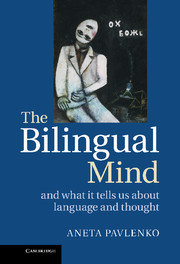Crossref Citations
This Book has been
cited by the following publications. This list is generated based on data provided by Crossref.
Babson, Andrew
2014.
Developing Possibilities for South African Youth.
The ANNALS of the American Academy of Political and Social Science,
Vol. 652,
Issue. 1,
p.
149.
Goutéraux, Pascale
2014.
L’appréciation et sa verbalisation en anglais langue étrangère.
Recherche et pratiques pédagogiques en langues de spécialité - Cahiers de l APLIUT,
Vol. Vol. XXXIII N° 2,
Issue. ,
p.
100.
Garton, Sue
and
Kubota, Ryuko
2015.
Joint colloquium on plurilingualism and language education: Opportunities and challenges, (AAAL/TESOL).
Language Teaching,
Vol. 48,
Issue. 3,
p.
417.
Pavlenko, Aneta
and
Volynsky, Maria
2015.
Motion Encoding in Russian and English: Moving Beyond Talmy's Typology.
The Modern Language Journal,
Vol. 99,
Issue. S1,
p.
32.
Lorette, Pernelle
and
Dewaele, Jean-Marc
2015.
Emotion recognition ability in English among L1 and LX users of English.
International Journal of Language and Culture,
Vol. 2,
Issue. 1,
p.
62.
Cowley, Stephen J.
and
Vork Steffensen, Sune
2015.
Coordination in language.
Interaction Studies. Social Behaviour and Communication in Biological and Artificial Systems,
Vol. 16,
Issue. 3,
p.
474.
Ng, Bee Chin
Cheryl, Tan Xue Er
Cavallaro, Francesco
and
Gottlieb, Halina
2015.
‘Touch’ Your Heritage: An Interactive Installation on Multilingual Identity.
International Journal of Heritage in the Digital Era,
Vol. 4,
Issue. 1,
p.
41.
2015.
Publications Received.
Language in Society,
Vol. 44,
Issue. 1,
p.
133.
Cook, Vivian
2015.
Discussing the Language and Thought of Motion in Second Language Speakers.
The Modern Language Journal,
Vol. 99,
Issue. S1,
p.
154.
Bylund, Emanuel
and
Athanasopoulos, Panos
2015.
Televised Whorf: Cognitive Restructuring in Advanced Foreign Language Learners as a Function of Audiovisual Media Exposure.
The Modern Language Journal,
Vol. 99,
Issue. S1,
p.
123.
Barrett, Lisa Feldman
2016.
The theory of constructed emotion: an active inference account of interoception and categorization.
Social Cognitive and Affective Neuroscience,
p.
nsw154.
Dewaele, Jean-Marc
and
Zeckel, Inga
2016.
The psychological and linguistic profiles of self-reported code-switchers.
International Journal of Bilingualism,
Vol. 20,
Issue. 5,
p.
594.
Malt, Barbara C.
Jobe, Rachel L.
Li, Ping
Pavlenko, Aneta
and
Ameel, Eef
2016.
What constrains simultaneous mastery of first and second language word use?.
International Journal of Bilingualism,
Vol. 20,
Issue. 6,
p.
684.
Hammer, Kate
2016.
Bilingual bonds.
International Journal of Language and Culture,
Vol. 3,
Issue. 2,
p.
253.
Yang, Wenxing
and
Sun, Ying
2016.
English and Mandarin speakers’ mental representations of time.
Review of Cognitive Linguistics,
Vol. 14,
Issue. 2,
p.
385.
Piller, Ingrid
2016.
Monolingual ways of seeing multilingualism.
Journal of Multicultural Discourses,
Vol. 11,
Issue. 1,
p.
25.
Athanasopoulos, Panos
and
Albright, Daniel
2016.
A Perceptual Learning Approach to the Whorfian Hypothesis: Supervised Classification of Motion.
Language Learning,
Vol. 66,
Issue. 3,
p.
666.
Jarvis, Scott
2016.
Clarifying the Scope of Conceptual Transfer.
Language Learning,
Vol. 66,
Issue. 3,
p.
608.
PELED, YAEL
and
BONOTTI, MATTEO
2016.
Tongue-Tied: Rawls, Political Philosophy and Metalinguistic Awareness.
American Political Science Review,
Vol. 110,
Issue. 4,
p.
798.
Vaid, Jyotsna
and
Meuter, Renata
2016.
The Cambridge Handbook of Linguistic Multi-Competence.
p.
77.



